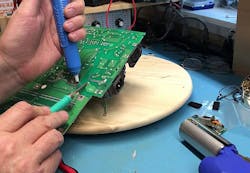The dark underside of defense industry prosperity
I haven't seen the defense industry this giddy in a long time. People are ready, once again, to spend company money on internal research and development in realistic hopes of landing some lucrative defense contracts. Some are kicking themselves for not anticipating the magnitude and pace of the defense industry turnaround. The biggest challenge these days seems to be simply keeping up, after having spent so long in recent years sweating over where the next contract is coming from.
Yet as with any industry in the throes of substantial growing pains, there's a downside to our industry's newfound prosperity: a steady stretching out of the supply chain as systems integrators scramble to fill orders, and suppliers try to deal with higher levels in demand than they've seen in years.
Today's there more demand for electronics parts than suppliers can fill -- and the problem seems to be getting worse, as the defense industry continues to ramp-up.
Related: 2019 DOD budget proposes $686.1 billion in military spending: largest Pentagon budget ever?
Need to order electronics parts from suppliers you haven't done a lot of business with lately? Good luck. As demand changes, so do rules of the supply chain. When supplies get tight, electronics parts distributors will take care of their best customers first. What, you're not one of your distributor's best customers? Then get in line. Your order will be filled ... when and if they can get to it. And don't hold your breath, either. The wait probably won't be just days; it'll most likely be weeks or even months.
While you're waiting for parts, moreover, your customers will be less than patient. In the midst of plenty, you'll be worried about losing contracts because you can get the parts fast enough to fill orders. The problem for your customers, however, is the parts squeeze hits across the industry; it's not likely that other systems designers can fill orders any faster than you.
There's a second problem in such a tight market: rising costs. Not only are parts suppliers serving their best customers first, but they also are serving their highest bidders. If you're willing to pay more, then it's more likely you'll have your parts orders filled more quickly than those who aren't.
How are electronics companies supposed to plan for this kind of thing? Growing demand, tight parts inventories, and rising costs can put a crimp in the best-laid plans. It's a mess brought on by good times that we've just got to deal with as best we can.
Related: Report: in 2018, global defense spending will reach highest level since Cold War
The good news is this won't go on forever. The market will sort itself out ... eventually. It just has to take its toll in headaches and sleepless nights first.
Here's another nagging thought: today's good times in the defense business won't last forever, either. The big question is low long will the wave last before it crashes ashore. I've seen some estimates that U.S. defense budgets will peak sometime between 2020 and 2022. After that it's expected to taper off as an overheated market cools off.
I worry that the defense economy will start to slow just as the parts supply chain catches up with peak demand. Then we'll have a surplus parts market and the problems that will bring. And so it goes.
Ready to make a purchase? Search the Military & Aerospace Electronics Buyer's Guide for companies, new products, press releases, and videos
